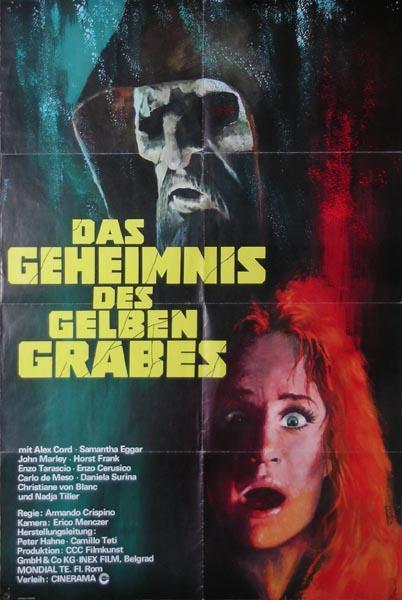The action takes place around an archaeological dig, led by Alex Cord's alcoholic professor. His ex from New York, who left him after he attempted to kill her in a drunken rage, also happens to live nearby, with her eccentric old lover, an orchestra conductor. The conductor's son happens to be the professor's main assistant. Amid all these coincidences and domestic wranglings, a killer is offing young couples, leaving the corpses posed in recreations of Etruscan art, and putting the same pair of red shoes on each slain woman. There are no shortage of suspects lining up for the local Inspector, but is the killer from modern times, or has an Etruscan returned to kill again?
The answer to that is, of course, no. As already stated, the film doesn't really engage with the Etruscan angle too much. It's a lengthy film-106 minutes-and there's a chance that some material which would have developed this subplot has been excised. There's evidence of snips elsewhere, with an occasional voiceover functioning as an extremely rudimentary commentary which would make Basil Exposition proud. The characters tend to be obliquely introduced too, with the audience having to connect the dots to work out who's who, and how they know each other, which may be further evidence of edits.
There are comparatively few murders, with a lengthy stretch between the second couple's murder (which is actually a single killing, as the male survives) and that of the third couple. The characters' histories are given a full airing in this section, which almost plays like one of Joe d'Amato's dramas, with less sex.We find out about doomed romances, secret wives and one of the guards who works at the burial site tries to work a blackmail scam. We get an almost too-neat selection of suspects from which to choose: the alcoholic archaeologist, his ex who survived his attempted murder, her jealous and crazy lover, the lover's secret-and scorned-wife, the gay choreographer who's secretly helping her, the son who witnessed his mother's infidelities, and the blackmailing guard.
It's no wonder the Inspector can't get to the bottom of it; everyone has an agenda. Unlike other gialli, where characters act suspiciously for no other reason than to attract the audience's attention as a form of misdirection, here that suspect behaviour is at least justified, given the complex personal histories at the root of it all. What we don't have is a motive; until the climactic revelation, there appears to be nothing concrete tying the murders together. The inspector offers up the usual 'sex maniac' theory after the first killings, and that's gradually elbowed aside by the vague sense that the murders are tied in with the Etruscans-after all, all the victims are either working at the dig site, or are killed there, but that isn't developed much further either.
So, no narratively-satisfying justification for the murders is offered until extremely late in the day. This wouldn't be an issue if there were more of them; however, there are only two proper murder scenes in the film. (The second attack, from which we get our sole survivor, happens off-screen.) Armando Crispino does seek to make up for that by including a reasonably entertaining car chase through narrow village streets (which obviously necessitated great care on the part of the drivers, and much speeding up of footage later on), and several scenes of characters stalking about in the dark. These scenes are solidly executed, if never spectacular, but they do showcase the film's wonderful locations well.
The end revelation isn't a great surprise, particularly as the film tips its hand somewhat by working overtime to cast suspicion on the two main protagonists (which, of course, means they're innocent). It's also a shame that more wasn't made of the Etruscan angle; the close-ups of the demonic painting, which stand in for the eyes of the killer in the classic giallo eye-insert shots, are nice and creepy. The demon as a whole looks great, even if the other paintings which inspire the murderer are a bit iffy.
As just stated, the locations are pretty spectacular, making this one of the most visually-pleasing rural gialli. It's certainly one of the best to listen to; Riz Ortolani's score is superb, and the musical crescendo which accompanies the discovery of the victims is great. It's certainly not a perfect film, and probably leans too far towards character history and psychology over plot and style, but you can see why it kick-started the craze for Etruscan dig gialli (see The Scorpion with Two Tails from 1982 for more on this).

 RSS Feed
RSS Feed
